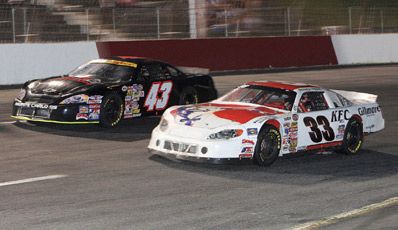
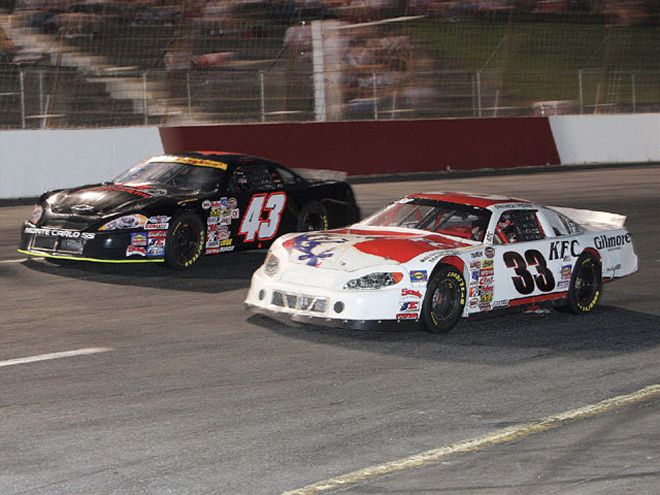 Taking measures to keep yourself cool and relatively comfortable behind the wheel isn't just for a pleasant evening of racing-it can also give you a competitive advantage over the competition.
Taking measures to keep yourself cool and relatively comfortable behind the wheel isn't just for a pleasant evening of racing-it can also give you a competitive advantage over the competition.
Here's a little "Did You Know?" that you might have missed in high school science class: The human body's core temperature is normally within the narrow range of 98 to 99 degrees F. When the core body temperature exceeds that by just a few degrees you go into heat exhaustion. And when it reaches 104 to 106 degrees you are in the danger zone of heat stroke.
So within a range of 8 degrees For less, you can go from perfectly healthy to risking death or permanent injury. This is not meant to be alarmist, but it just goes to show the importance of protecting yourself-not just from a wreck, but also from heat-when you are inside your racecar.
Granted, the human body can take quite a bit of punishment before it allows core body temps to reach the danger zone. Driving a feature race in a racecar in July doesn't guarantee heat stroke, but we all know that the environment inside a racecar can often be a lot like spending a half hour or more in an oven.
Rick Shafer of Cool Shirt is one of the most knowledgeable people in the racing industry on the subject of just how heat affects racecar drivers, both mentally and physically. He not only has done extensive research himself, but he's also gathered the research results of such organizations as NASA and applied their findings to our sport.
Before you can understand exactly how important some sort of cooling method is to the racer, you must first understand the science of how the body cools itself naturally. Shafer points out that there are four ways the body gets rid of excess heat. Just as a matter of living and breathing-not necessarily exercising or racing-the human body generates up to 50 degrees of extra heat over a 24 hour period. Approximately 65 percent of that is released through radiation, which occurs when the air temperature is lower than the body's temperature. Ten to 15 percent of body heat is lost through convection, which is, according to Shafer, heat loss to air and water vapor around your body which must be lower than your skin temperature. Conduction, which is the transfer of heat from warmer to cooler objects by direct contact, accounts for only two percent. And finally, evaporation, which is the release of perspiration through the sweat glands which cools the body when the liquid evaporates, is responsible for the final 25 percent.
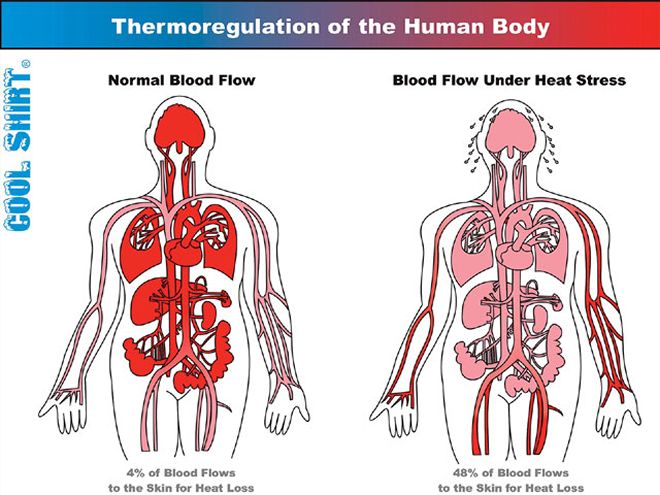 When your core body temp rises, the body tries to vent excess heat by routing more blood to the surface of the skin. This pulls needed blood away from vital organs such as your heart and brain which can affect your performance on the track.
When your core body temp rises, the body tries to vent excess heat by routing more blood to the surface of the skin. This pulls needed blood away from vital organs such as your heart and brain which can affect your performance on the track.
The important part to understand here is that when the air temperature around you is over 95 degrees, three of the four methods the body uses to cool itself no longer work. Only evaporation is still a reliable method.
Now consider the fact that in order to protect himself or herself from the threat of fire, a racecar driver must wear a protective driver's suit that is not only flame-retardant, but also able to insulate the driver's body from extreme heat. "The insulating qualities of a good driver's suit are important," says Bob Mantell, executive sales director of safety equipment manufacturer RaceQuip. "The thing you have to understand is that the suit is about thermal protection. It's not the flame that burns you inside the suit, it's the heat. Unfortunately, the suit also works in reverse. The heat you generate as you drive the racecar is trapped inside the suit."
So in an environment where the air temperature is over 95 degrees (and how often does that happen inside your racecar?) you have already lost three of the four ways your body cools itself, and now you've put on a driver's suit that not only traps the heat your body generates against you but also isn't breathable so the sweat your body produces isn't evaporating. Can you see how overheating can be a concern?
Just like overheating your engine can result in stuck exhaust valves, cracked cylinder heads, and detonation, there are very tangible-and very negative-effects when your body overheats. Again, we'll refer to research Cool Shirt's Shafer has compiled and shared with us.
The first thing we need to understand is how the body physiologically handles heat removal. The typical person has approximately 5.6 liters of blood coursing through his veins. For normal heat loss, Shafer says one-fourth of a liter is sent to your skin per minute to aid cooling. This heat is transferred through the blood to the skin to be lost through one of the four methods mentioned earlier. But when heavy perspiration occurs the body ups the ante considerably. Now, up to half of your blood is sent to the skin's surface (that's why you get flushed) to get as much heat out as possible. This means your body's organs, muscles and your brain are only working on half of the oxygen-providing blood supply they normally have at their disposal (see the illustration at the top of this page.)
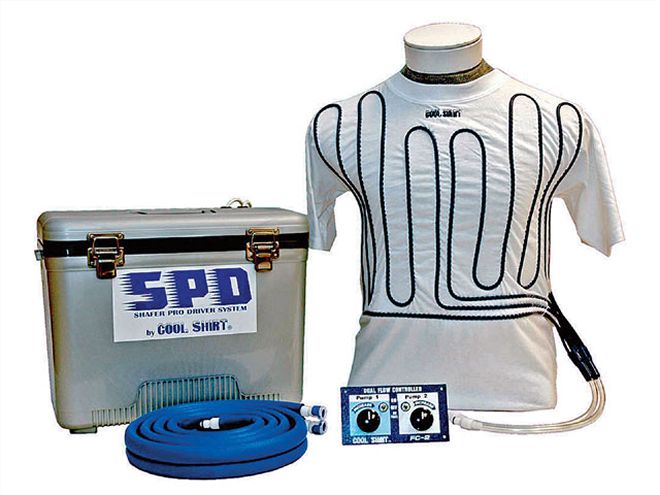 The Cool Shirt is a very effective means of cooling the body because cool water is much more effective at pulling away heat than air.
The Cool Shirt is a very effective means of cooling the body because cool water is much more effective at pulling away heat than air.
As you can imagine, this change in blood flow has several effects on the body, and none of them are exactly good for driving a racecar. During this time you will fatigue much more quickly than a driver that is cooler, your reaction time can be slowed, and your ability to make good decisions quickly will be impeded.
So you can see why finding a way to keep your cool is not only about personal comfort, but can actually result in higher finishes, fewer wrecks and greater safety on the racetrack. It's not being a sissy to make an effort to keep from sweating buckets at every race, it's searching for a competitive advantage just like the chassis setup you've worked sohard to perfect.
With that in mind, CIRCLE TRACK has put together a few ideas to help you keep your cool behind the wheel. Of course, you should also consider the obvious solution such as ducting some outside air to blow on your chest and possibly even a blower to provide a fresh supply of air inside your helmet. But these ideas can also help give you that edge you've been searching for.
We've already mentioned Cool Shirt's Rich Shafer and the work he's done trying to understand just how the body reacts to excess heat and the ways it gets rid of it. And his product, the Cool Shirt, is the result of his extensive research and testing on the best way to help get rid of excess heat. The Cool Shirt works by integrating surgical-grade tubing into a shirt that you wear underneath your driver's suit. A small electric pump pushes water from a cooler through the tubing to pull heat away from your body. The shirt doesn't freeze you because the water is only at 45 to 60 degrees, but it does an incredible job of cooling you because the shirt covers 30 to 40 percent of your skin's surface area and cool water transfers heat 28 times faster than air.
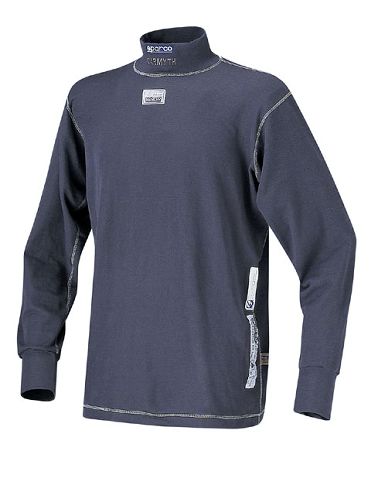 It is hard to explain exactly how it works, but Sparco's X-Cool treatment on racing underwear and the inner liner of driving suits activates when your body temperature elevates providing a cooling effect.
It is hard to explain exactly how it works, but Sparco's X-Cool treatment on racing underwear and the inner liner of driving suits activates when your body temperature elevates providing a cooling effect.
Shafer says that the Cool Shirt not only reduces overheating, but because perspiration is decreased you also run less risk of dehydration. The cooler can easily be strapped down inside your car so it isn't bouncing around, and the weight penalty isn't bothersome at all.
Last year, Sparco USA introduced its X-Cool line of products. At the time they were used mainly by Champ Car drivers, but now the line is growing for products aimed at Saturday night racers. X-Cool is a treatment that is added to a garment. In Sparco's words it "...is a chemical treatment applied to the fabric consisting of microcapsules that are liberated as temperature rises. The molecules move in a direction away from the heat source (the body) which contributes to lowering the body temperature. This active ingredient also contains an essence of menthol which is released as the molecules move."
In plain English, when your body heat elevates, the molecules in the X-Cool treatment activate and try to move away from the heat. Somehow (and we will leave that to the chemists) it has a cooling effect, and apparently, it works. "The feedback we got back from the IRL and Champ Car drivers after last season has really been excellent," says Sparco USA's Warren Caswell. "We are now applying it to our super light, breathable underwear as well as the inner liner of some of our driving suits, and when you combine them the effect really is strong."
Because it is a chemical treatment, the X-Cool will wear off after 15 to 20 washings, but Sparco is introducing a re-treatment kit this year that will allow you to re-treat your garments. Caswell says that the re-treatment process will be simple so that anyone can do it themselves at home and very cost effective. When asked if the re-treatment kit would work with non-Sparco pieces of gear, Caswell said he wasn't sure but did say that the more breathable the fabric, the better the X-Cool treatment would work.
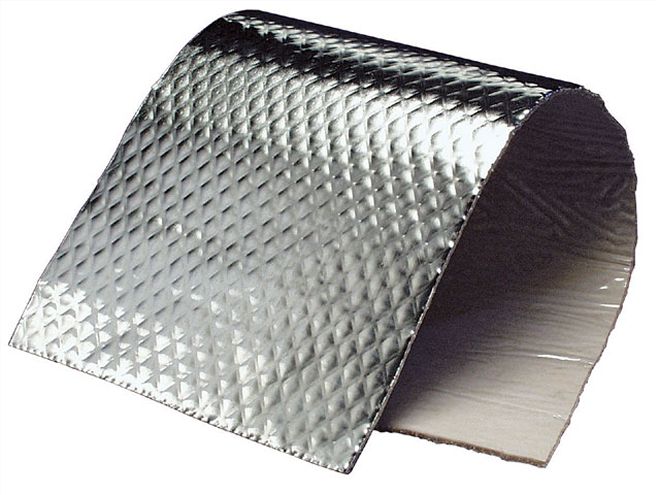 One simple way to keep cooler is to keep the heat produced from the engine from invading the driver's compartment. DEI's Floor and Tunnel Shield is a fl exible refl ective shielding that can be stuck directly to the underside of the fl oorboard to refl ect away heat from the exhaust pipes before it gets to you.
One simple way to keep cooler is to keep the heat produced from the engine from invading the driver's compartment. DEI's Floor and Tunnel Shield is a fl exible refl ective shielding that can be stuck directly to the underside of the fl oorboard to refl ect away heat from the exhaust pipes before it gets to you.
One reason the cockpit of a racecar gets so hot is because of the intense heat produced by the high output engine operating for extended periods at full throttle. Because there is usually no insulation, the heat from the engine and exhaust pipes quickly radiate through the sheet metal and into the car's interior.
So it only makes sense that you can cut some heat by DEI (Design Engineering, Inc.) produces several products designed to work in hot environments, and one of the newest-and most interesting to racers-is its Floor and Tunnel Shield. The product reflects as well as insulates heat and is designed to be used on the underside of the floor of the car to keep heat from actually getting into the car.
Floor and Tunnel Shield uses a reflective 10 millimeter flexible aluminum sheet bonded to a 3/16-inch thick layer of fiberglass insulation. It is backed by an adhesive so that you peel off the backing and then stick it to the underside of the car. The material is flexible, so you can form it to the curvature of the surface. The ideal place for this is directly above the exhaust pipes so that the extreme heat from the pipes cannot get into the car.
At first we had reservations that a stick-on product would hold up to the rigors-and abuses-of a season's worth of racing. But then we learned that Floor and Tunnel Shield was tested by applying pieces to the mud flaps of 40-foot trailers and underneath the frames of large trucks for an entire winter of durability testing in the Northeast United States and made it through with no signs of excessive wear. The shield material is lightweight, but any weight penalty isn't much of a problem since it is designed to be placed so low on the car any way. DEI says the product can withstand 1,750 degrees F of continuous heat while reflecting 90 percent of that heat away. Only 3/16-inch of clearance is required for maximum protection.
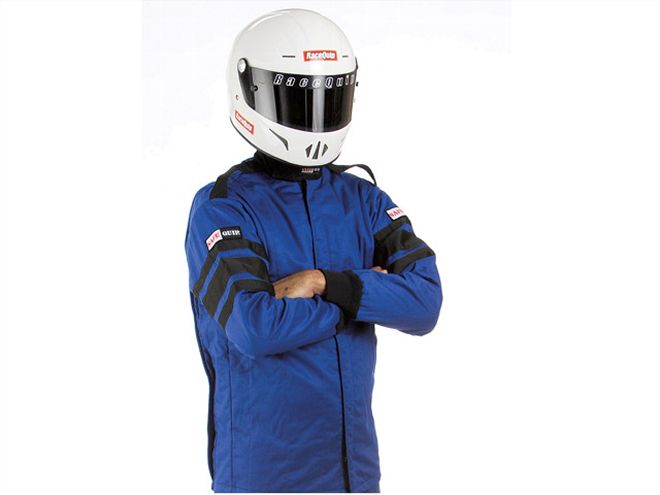 RaceQuip offers driving suits with a fl ame resistant cotton inner liner. The protection is the same as other suits, but the cottonbased inner liner pulls sweat away from the body to make you more comfortable.
RaceQuip offers driving suits with a fl ame resistant cotton inner liner. The protection is the same as other suits, but the cottonbased inner liner pulls sweat away from the body to make you more comfortable.
There is a reason why you wear cotton shirts working around the shop instead of something constructed out of Nomex. Nomex is great as a fire resistant material, but there is simply nothing as comfortable as cotton. Cotton absorbs sweat and is also very breathable. Modern technology has produced flame resistant cotton blends that work very well as an inner liner in driving suits.
"One of the things you can do to help stay a little cooler is choose the right type of underwear and the right suits," says RaceQuip's Mantell. "Nomex-based products work well as protection, but they just aren't as comfortable to wear as cotton-based products. If a suit has an interior layer that's against your skin and it's flame resistant cotton, then it will be cooler to wear than a similar suit that has a Nomex layer against your skin.
"It's really a perception of how cool you are," he continues. "If the TPP numbers (a measure of the thermal protection factor) are the same, then the insulation factor is roughly the same. The difference is the cotton will wick the moisture away from your skin so you aren't sitting in your own sweat and you will feel cooler."
Keeping yourself cool in the racecar is not only good for your health, but can also give you and edge over the competition. But best of all, these suggestions are pretty easy to implement. So, as the summer months approach take stock of how you keep your body cool, update if necessary, and go out and win some races.
Cool Shirt's Rich Shafer provided us this list of symptoms of heat exhaustion. If you are feeling more than one or two of these symptoms after getting out of the racecar, you should seriously consider increasing the cooling measures inside your racecar:
* Heavy perspiration
* Fatigue and weakness
* Skin is cold, pale, and clammy
* Muscle and body ache
* Headache
* Nausea
* Vomiting and/or collapse with or without loss of consciousness
* Skin is hot, dry, and red
* Rapid heartbeat
* Confusion
* Loss of consciousness